Education activism films serve as powerful tools for promoting reform advocacy and highlighting educational inequities in the UK. By intertwining personal narratives with systemic critiques, these films make complex issues more relatable and inspire viewers to take action. Through compelling storytelling, they illustrate the real-life impacts of educational disparities, motivating audiences to engage in meaningful advocacy for change.
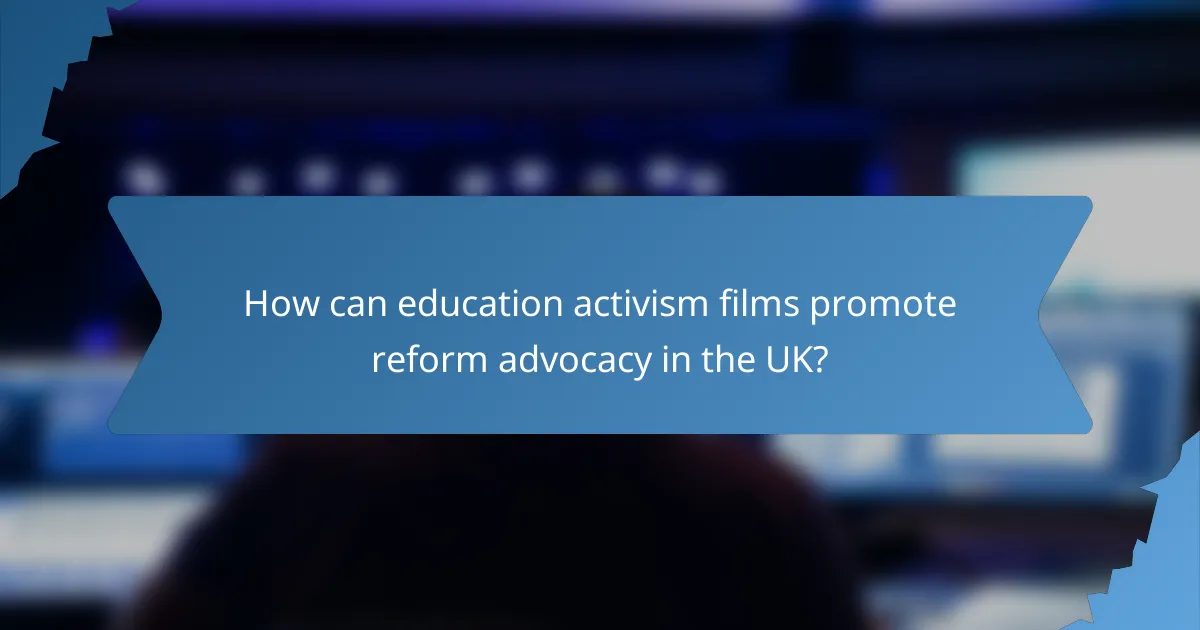
How can education activism films promote reform advocacy in the UK?
Education activism films can effectively promote reform advocacy in the UK by raising awareness of educational inequities and inspiring action among viewers. These films often combine personal narratives with broader systemic critiques, making complex issues more relatable and motivating audiences to engage in advocacy efforts.
Highlighting systemic issues
Education activism films shine a light on systemic issues within the UK education system, such as funding disparities and access to quality resources. By presenting real-life stories of students and educators facing these challenges, the films create a compelling narrative that illustrates the urgent need for reform.
For example, a film might explore the impact of socioeconomic status on educational outcomes, showcasing how students from disadvantaged backgrounds struggle to receive the same opportunities as their peers. This approach not only informs viewers but also fosters empathy and a desire for change.
Showcasing successful initiatives
These films often highlight successful initiatives that have led to positive changes in education, serving as models for reform. By documenting programs that have improved student engagement or increased funding for under-resourced schools, the films provide concrete examples of what can be achieved through advocacy.
For instance, a documentary might feature a community-led project that successfully lobbied for increased school budgets, demonstrating how collective action can lead to tangible results. This can inspire viewers to replicate similar efforts in their own communities.
Engaging community stakeholders
Education activism films play a crucial role in engaging community stakeholders, including parents, educators, and policymakers. By presenting diverse perspectives, these films encourage dialogue and collaboration among those invested in educational reform.
To maximize impact, filmmakers can organize screenings followed by discussions, allowing viewers to share their thoughts and experiences. This engagement can lead to grassroots movements and partnerships that drive advocacy efforts forward, ultimately fostering a more equitable education system in the UK.
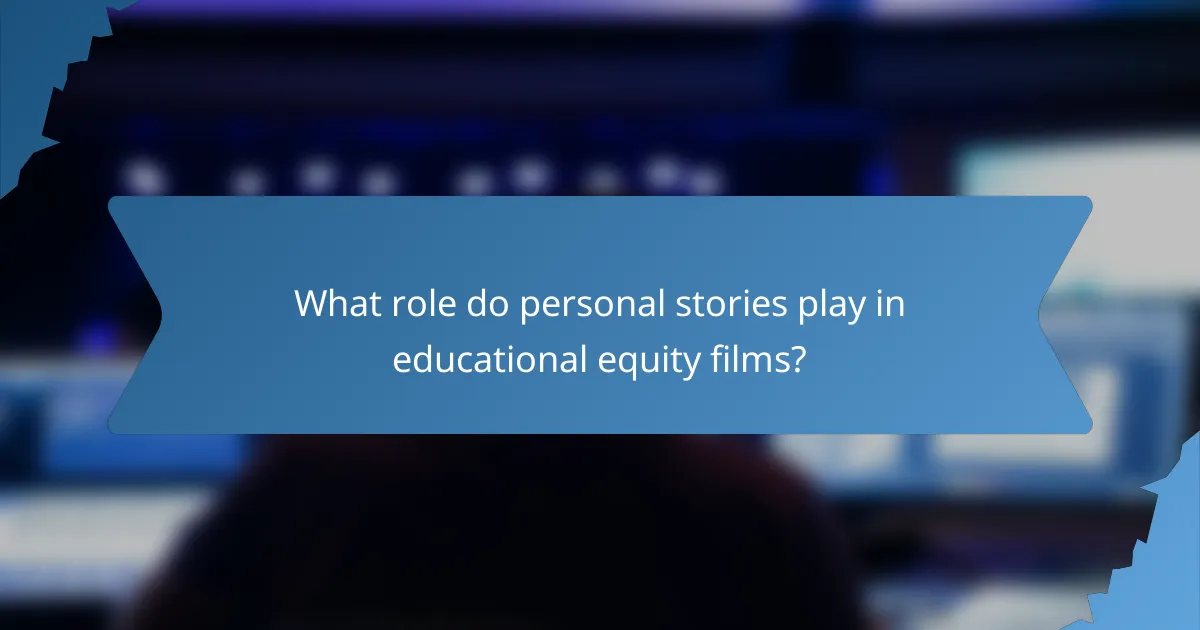
What role do personal stories play in educational equity films?
Personal stories are crucial in educational equity films as they illustrate the real-life impact of systemic issues on individuals. These narratives provide a relatable context that can drive awareness and inspire action towards reform.
Humanizing complex issues
Educational equity often involves intricate topics such as funding disparities, access to resources, and policy implications. Personal stories simplify these complexities by showcasing how these issues affect real people, making them more relatable and understandable. For instance, a film might follow a student’s journey through an underfunded school, highlighting the challenges they face and the resilience they demonstrate.
By focusing on individual experiences, filmmakers can break down abstract concepts into tangible realities, allowing audiences to grasp the urgency of educational reform. This humanization fosters a deeper connection to the issues at hand.
Building empathy and understanding
Empathy is a powerful tool in advocacy, and personal stories in educational equity films serve to cultivate it. When viewers see the struggles and triumphs of individuals from diverse backgrounds, they are more likely to understand the systemic barriers that exist. This emotional engagement can motivate audiences to support initiatives aimed at promoting equity.
For example, a documentary might feature interviews with teachers and students, sharing their personal challenges and victories. These narratives can evoke compassion and inspire community members to take action, whether through volunteering, advocacy, or financial support for educational programs.
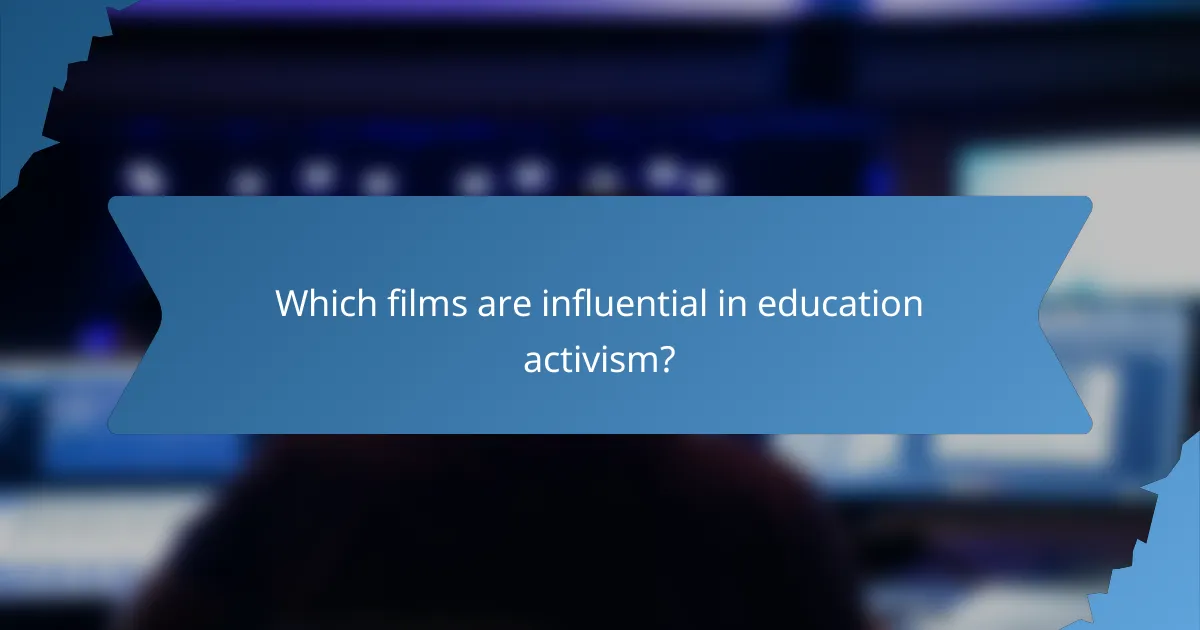
Which films are influential in education activism?
Several films have played a significant role in education activism by highlighting issues of reform advocacy, educational equity, and personal stories. These films often provoke thought and inspire action among viewers, making them essential viewing for those interested in improving education systems.
“Waiting for Superman”
“Waiting for Superman” focuses on the challenges faced by the American public education system, particularly in urban areas. It follows several students as they navigate a flawed system, emphasizing the impact of school choice and the need for reform.
The film critiques the bureaucracy of public schools and advocates for charter schools as a potential solution. It encourages viewers to consider how educational policies affect individual students and their futures.
“The First Year”
“The First Year” documents the experiences of novice teachers in their inaugural year in the classroom. It provides a raw look at the challenges and triumphs they face while trying to make a difference in their students’ lives.
This film highlights the importance of support systems for new educators and the realities of teaching in under-resourced schools. It serves as a reminder of the dedication required to foster educational equity.
“Teach Us All”
“Teach Us All” addresses the ongoing issues of racial and socioeconomic disparities in education. The film examines the historical context of these inequalities and their present-day implications for students across the United States.
By featuring personal stories and expert insights, it calls for collective action to ensure that all students have access to quality education. The film encourages viewers to engage in advocacy for systemic change in educational policies.
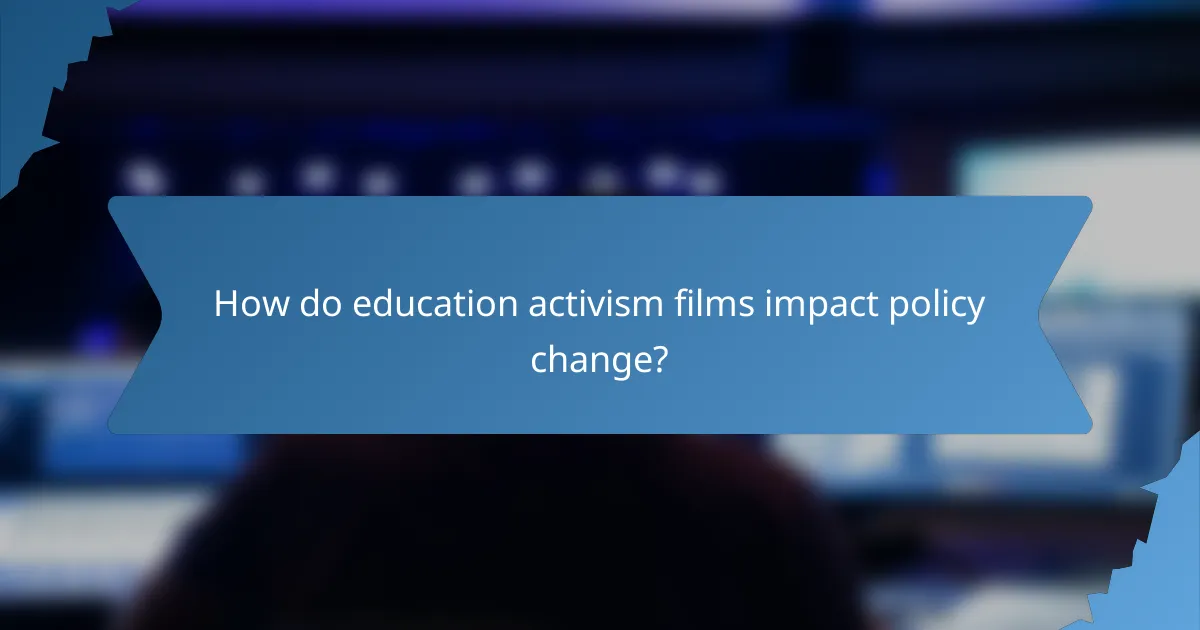
How do education activism films impact policy change?
Education activism films significantly influence policy change by raising awareness and shaping public discourse around educational equity. These films often highlight personal stories that resonate with viewers, prompting them to advocate for reforms and engage with policymakers.
Raising public awareness
Education activism films serve as powerful tools for raising public awareness about systemic issues in education. By showcasing personal narratives and real-life challenges faced by students and educators, these films can evoke empathy and inspire action among viewers.
For instance, a film that follows the journey of a low-income student navigating a failing school can illustrate the urgent need for reform. This emotional connection can mobilize community members to demand changes from local school boards or state education departments.
Influencing legislative discussions
These films can directly influence legislative discussions by providing compelling evidence and narratives that lawmakers cannot ignore. When legislators view or hear about impactful films, they may be prompted to consider new policies or amendments that address the highlighted issues.
Moreover, screenings of these films often include discussions with educators, activists, and policymakers, creating a platform for dialogue. This engagement can lead to the drafting of bills aimed at increasing funding for under-resourced schools or implementing new educational standards.
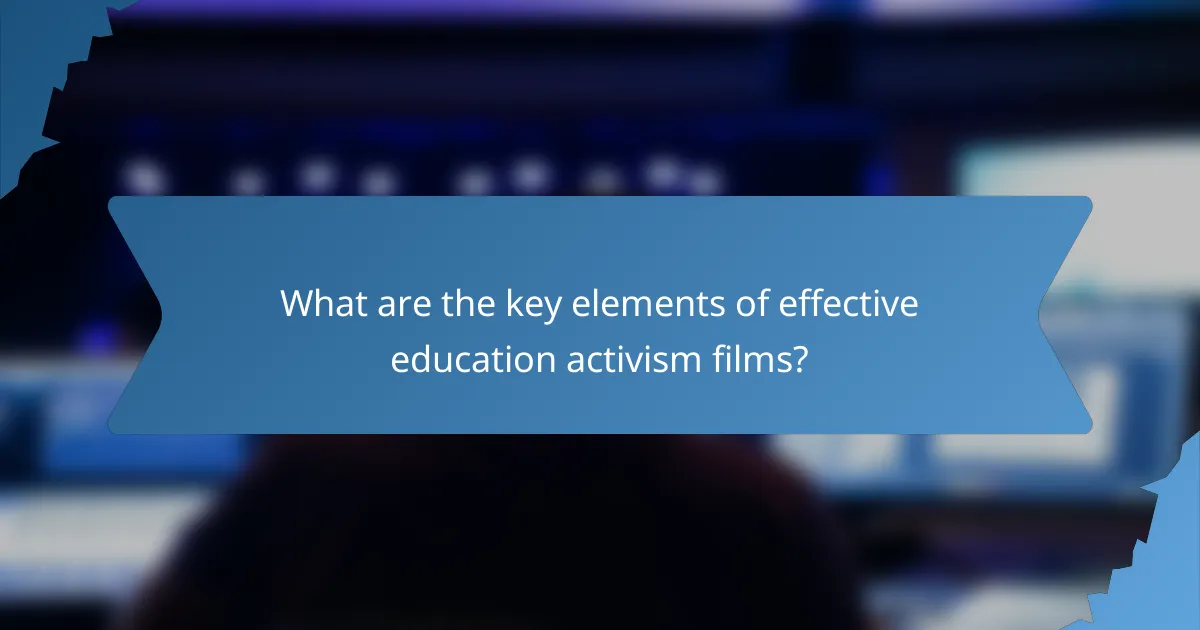
What are the key elements of effective education activism films?
Effective education activism films combine strong storytelling, authentic representation, and a clear message to advocate for reform and educational equity. These elements engage audiences emotionally and intellectually, driving awareness and action.
Strong narrative structure
A strong narrative structure is essential for education activism films as it guides the viewer through a compelling story. This typically includes a clear beginning, middle, and end, where the initial problem is introduced, followed by the journey towards resolution, and concluding with a call to action.
To create an impactful narrative, filmmakers should focus on character development and conflict. Personal stories of individuals affected by educational inequities can serve as powerful anchors, making the issue relatable and urgent. For instance, showcasing a student’s struggles can highlight systemic problems and inspire empathy.
Authentic representation
Authentic representation is crucial in education activism films to ensure that the voices and experiences of marginalized communities are accurately portrayed. This involves involving individuals from these communities in the filmmaking process, which can enhance credibility and relatability.
Filmmakers should prioritize diversity in casting and storytelling, reflecting the real demographics of the educational landscape. Additionally, using real-life testimonials and experiences can strengthen the film’s message. For example, featuring educators and students from various backgrounds can illustrate the multifaceted nature of educational challenges and solutions.
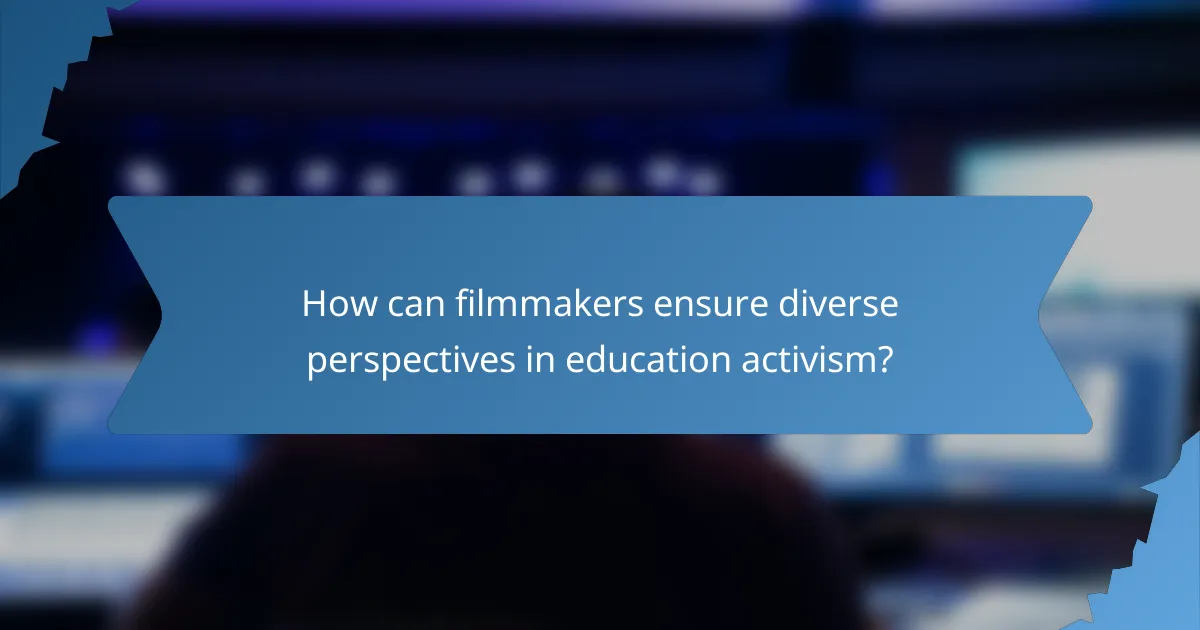
How can filmmakers ensure diverse perspectives in education activism?
Filmmakers can ensure diverse perspectives in education activism by actively seeking out and including voices from various backgrounds, particularly those that are often marginalized. This approach not only enriches the narrative but also fosters a more inclusive dialogue around educational equity.
Involving marginalized voices
Incorporating marginalized voices is crucial for authentic representation in education activism films. Filmmakers should prioritize interviews and stories from individuals who have firsthand experience with educational inequities, such as students from low-income families or those with disabilities. This can help illuminate the real challenges faced in the education system.
To effectively involve these voices, filmmakers can partner with local organizations that work directly with underrepresented communities. This collaboration can facilitate access to stories that might otherwise remain untold and ensure that the narratives presented are both accurate and impactful.
Collaborating with local communities
Collaboration with local communities is essential for creating films that resonate with the audience and reflect their realities. Filmmakers should engage community members in the storytelling process, allowing them to share their experiences and insights. This not only builds trust but also enhances the film’s credibility.
Practical steps include hosting community forums or workshops where individuals can discuss their educational experiences. Filmmakers can also consider co-creating content with local artists or educators, which can lead to richer, more nuanced portrayals of educational issues. By investing time in these relationships, filmmakers can create a more inclusive and representative narrative.
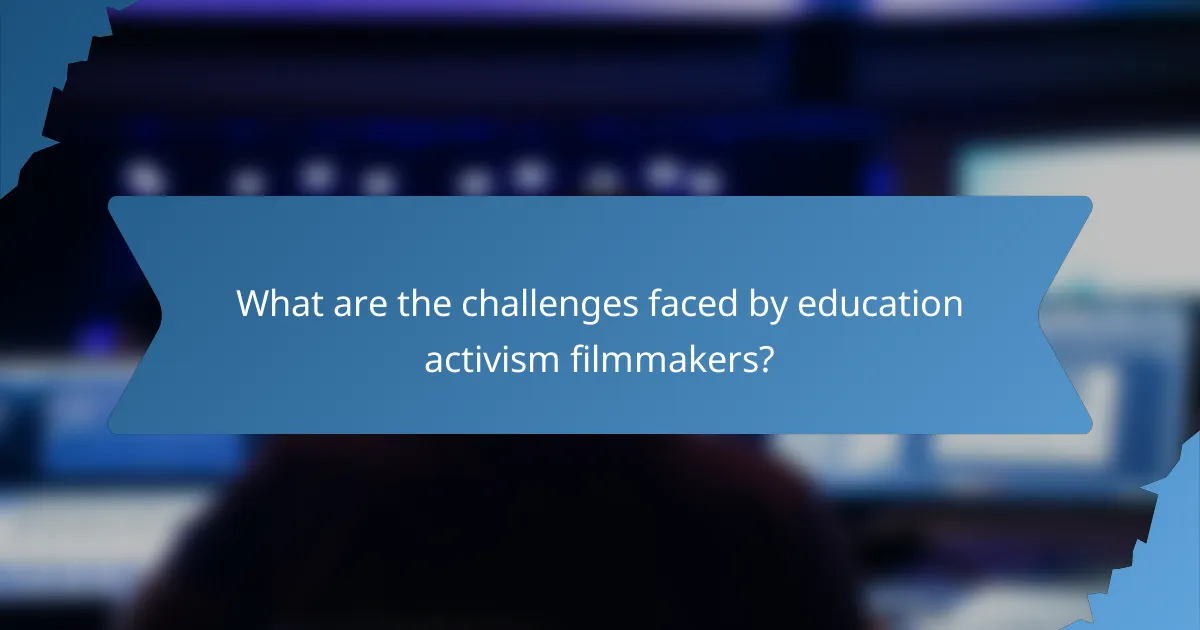
What are the challenges faced by education activism filmmakers?
Education activism filmmakers encounter several significant challenges, including securing funding and gaining access to subjects. These obstacles can hinder their ability to effectively tell stories that advocate for educational reform and equity.
Funding limitations
Funding limitations are a primary challenge for filmmakers focused on education activism. Many projects rely on grants, donations, or crowdfunding, which can be unpredictable and insufficient to cover production costs. Filmmakers often need to create compelling proposals to attract financial support, emphasizing the social impact of their work.
Additionally, competition for funding can be fierce, with numerous projects vying for the same resources. Filmmakers should consider diversifying their funding sources, including partnerships with non-profits or educational institutions, to enhance their financial stability.
Access to subjects
Access to subjects is crucial for education activism filmmakers, as personal stories often drive the narrative. Filmmakers may face challenges in reaching out to individuals or communities willing to share their experiences, especially in sensitive contexts. Establishing trust and rapport is essential to encourage participation.
Moreover, legal and ethical considerations can complicate access. Filmmakers must navigate consent issues and ensure that they represent subjects’ stories accurately and respectfully. Building relationships with local organizations can facilitate access and provide valuable insights into the communities being portrayed.

How can audiences engage with education activism films?
Audiences can engage with education activism films by actively participating in discussions, sharing their insights, and supporting initiatives that promote educational equity. These films often highlight personal stories and systemic issues, making it essential for viewers to reflect on their own experiences and advocate for change.
Participating in Discussions
Engaging in discussions around education activism films can deepen understanding and inspire action. Viewers can join online forums, attend screenings, or participate in Q&A sessions with filmmakers and educators. Sharing perspectives and insights fosters a community focused on reform advocacy.
Supporting Educational Initiatives
Supporting educational initiatives is a practical way to engage with the themes presented in these films. This can include donating to organizations that promote educational equity, volunteering for local schools, or advocating for policy changes. Small contributions can collectively make a significant impact.
Sharing Personal Stories
Sharing personal stories related to education can amplify the message of activism films. Individuals can write blogs, create videos, or participate in social media campaigns to highlight their experiences. Personal narratives can resonate with others and encourage them to reflect on their own educational journeys.
Advocating for Policy Change
Advocating for policy change is a crucial step in addressing the issues raised in education activism films. Audiences can contact local representatives, participate in community meetings, or join advocacy groups focused on educational reform. Effective advocacy often involves presenting compelling evidence and personal stories to influence decision-makers.
